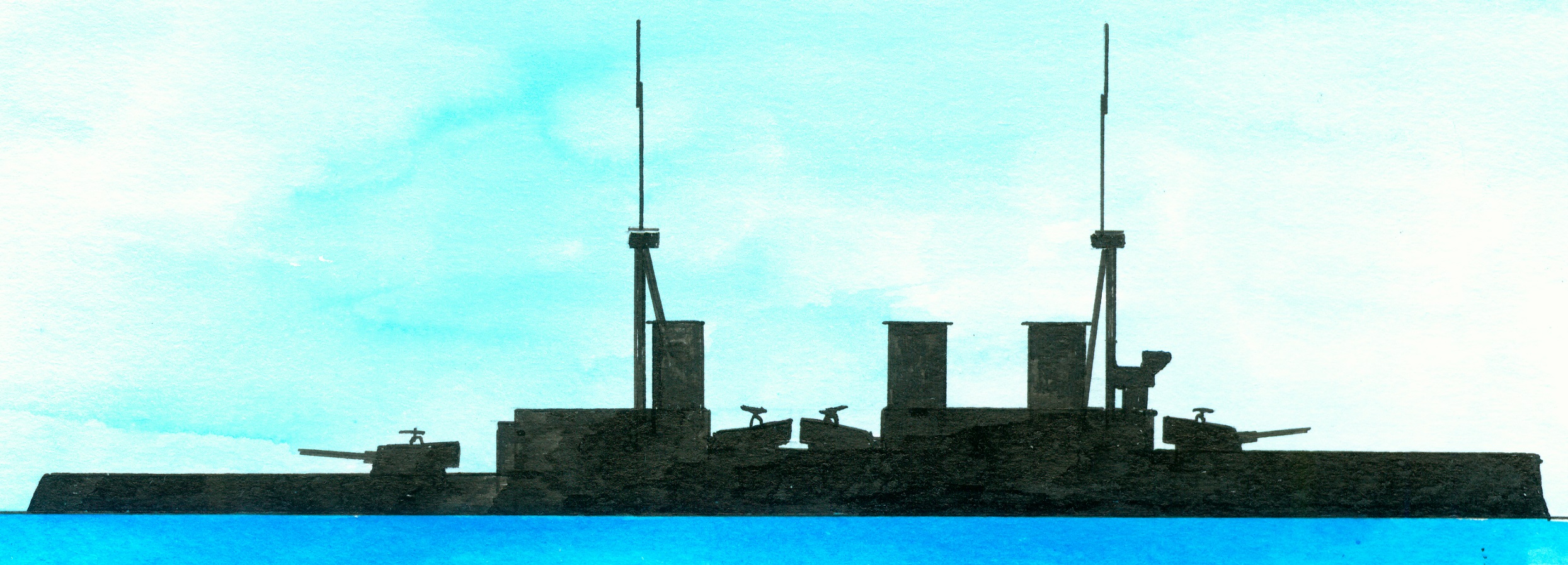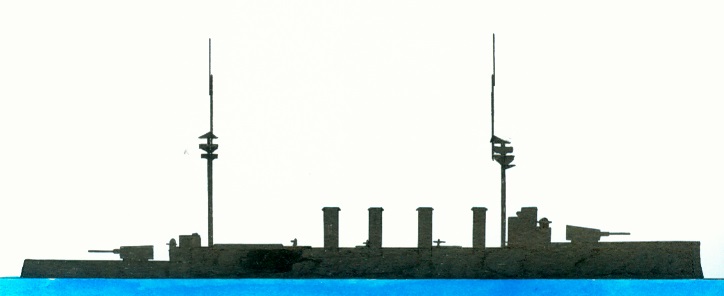German Derfflinger-class battle cruisers
British Invincible-class battle cruisers
British Minotaur-class armoured cruisers
British Duke of Edingburgh-class armoured cruisers
British Warrior-class armoured cruisers
Notes
1. Battle of Jutland or Skagerrak between the British and German navies 31 May-1 June 1916. British losses 6.094 men killed, 674 men wounded, 3 battle cruisers, 3 armoured cruisers, 8 destroyers total tonnage lost 113.300 tons and German losses 2.551 men killed, 507 wounded, 1 battle cruiser, 1 pre-dreadnought, 4 light cruisers, total tonnage 62.300 tons.
2. Of the Derfflinger-class, consisting of the Derfflinger, Lützow and the Hindenburg with a modernized design, preceded by the Seydlitz and succeeded by the never built Mackensen-class. Building ordered under 1912-1913 Naval Program, laid down by Blohm&Voss, Hamburg, Germany with yard number 213on 30 March 1912, launching planned on 14 June 1913 but failed when wooden sledges jammed, launched on 17 July 1913, commissioned on 1 September 1914, scuttled at Scapa Flow, Orkney Isles, Scotland on 21 June 1919, wreck salvaged in 1939, anchored in capsized condition off the island of Risa, sent to Faslane Port in 1946 where the breaking was completed in 1948. Nicknamed Iron Dog.
3. Of the Derfflinger-class, consisting of the Derfflinger, Lützow and the Hindenburg with a modernized design, preceded by the Seydlitz and succeeded by the never built Mackensen-class. Building ordered under the 1912-1913 Naval Programme as the Ersatz Kaiserin Augusta, laid down at the Schichau-Werft, Danzig with yard number 885 in May 1912, launched on 29 November 1913, commissioned for executing trials on 8 August 1915, full commissioned in March 1916, heavily damaged during the Battle of Jutland and scuttled on 1 June 1916.
4. Of the Queen Mary class, consisting of just one ship. Preceded by the Lion-class and succeeded by the HMS Tiger. Built under the 1910-1911 Naval Programme. :aid down by Palmers Shipbuilding and Iron Company, Jarrow, England on 6 March 1911, launched on 20 March 1912, completed in August 1913, commissioned on 4 September 1913 sunk during the battle of Jutland against German naval forces on 31 May 1916
5. Laid down at the Devonport Dock yard on 23 February 1909 ordered by the 1908-1909 Naval Programme and launched on 28 October that same year, commissioned on 24 February 1911 and sunk during the battle of Jutland against German naval forces on 31 May 1916. Only ship of her class.
6. Of the Invincible-class consisting of the Invincible, Indomitable and Inflexible. Laid down at the shipyard of Armstrong, Whitworth&Co. Ltd, Tyneside, Elswick, England on 2 April 1906, launched at 3 p.m. by Lady Allendale on 13 April 1907, officially completed on 16 March 1909, commissioned on 20 March 1909 and sunk on 31 May 1916 during the Battle of Jutland when a magazine exploded after the Q turret was hit.
7. Laid down at the Pembroke Dockyard on 25 February 1905, launched on 24 April 1907, commissioned on 9 February 1909, participated in the unsuccessful pursuit of the German battle cruiser SMS Goeben and light cruiser Breslau underway towards Turkey and sunk during the Battle of Jutland with her entire crew on 31 May 1916. She attacked the SMS Wiesbaden when she was destroyed by gunfire of the German SMS battle cruiser Derfflinger and four battleships. Building costs 1.362.970 pond sterling. British Minotaur-class armoured cruisers consisting of the Defence, Minotaur and Shannon, preceded by the Duke of Edinburgh-class but not succeeded by a new class of armoured cruiser, but in fact by the Invincible-class of battle cruisers. Not a really successful design while armour was offered to compensate the extra weight of their heavy armament.
8. Laid down at the Thames Ironworks and Shipbuilding Company, Blackwall, London, England on 3 June 1903, launched on 8 November 1904, commissioned on 17 March 1906 and sunk during the Battle of Jutland against the German fleet on 31 May 1916. With numerous hits scored by German warships like the battleships Thüringen (1), Nassau (2), Ostfriesland (3) and Friedrich der Grosse (4) sank she within 15 minutes with her entire crew of 857 men. Building cost 1.193.414 pound sterling. Of the Duke of Edinburg-class consisting of the Duke of Edinburgh and the Black Prince, designed by director of naval construction sir Philip Watts (5), preceded by the Devonshire-class and succeeded by the Warrior-class. Built under the 1902-1903 Naval Estimates.
9. Laid down at Pembroke Dockyard, Pembroke Dock on 5 November 1903, launched on 25 November 1905, completed on 12 December 1906, participated in the Battle of Jutland on 31 May 1916 and such heavily damaged by German gunfire of the German battle cruiser Derfflinger and battleships and despite towed away by the seaplane tender HMS Engadine forced to be abandoned at 8:25 o’clock on 1 June 1916. Building costs 1.186.395 pond sterling. Machinery manufactured by Wallsend Slipway and Engineering. Built under the 1903-1904 Naval Programme. Of the Warrior-class consisting of the Warrior, Achilles. Cochrane and Natal., preceded by the Duke of Edinburg-class and succeeded by the Minotaur-class.





